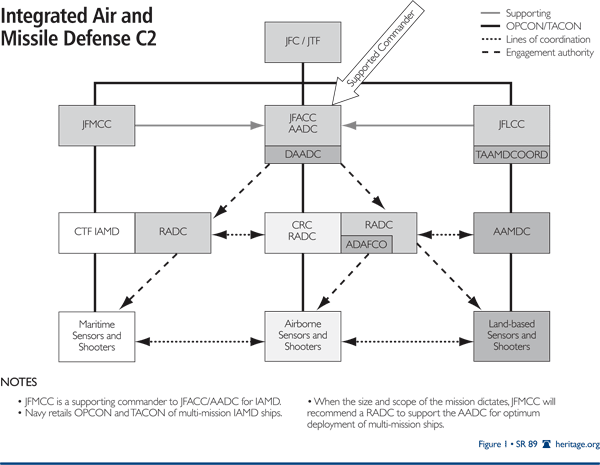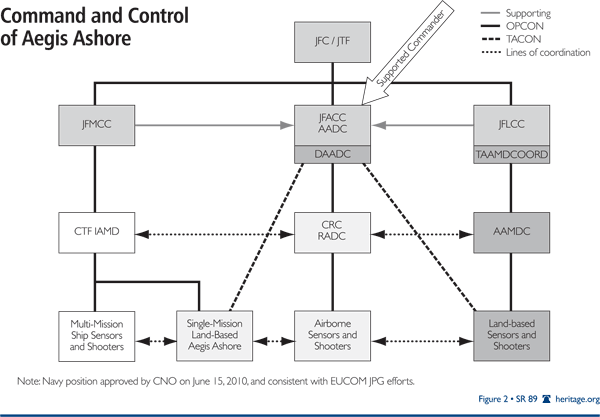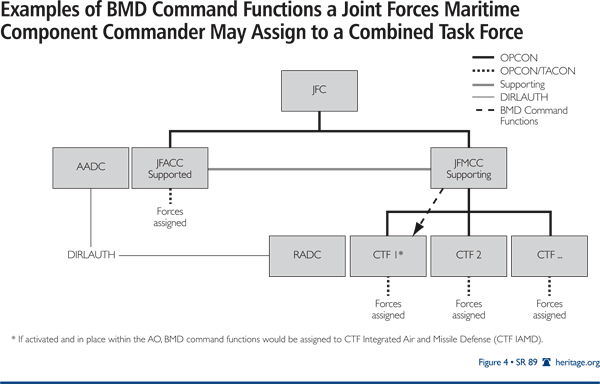Abstract: The Navy has worked hard to develop the command and control system for the Aegis ballistic missile defense (BMD) system. Initial emphasis by both the Missile Defense Agency and the Navy was on acquiring a reliable ballistic missile interceptor. Only recently has there been a focused effort to develop the command and control system to support the currently available Standard Missile 3 Block IA BMD interceptor, which is on board select Navy cruisers and destroyers. The focus on improving Aegis command and control for BMD is necessary for two reasons. The first is to improve the reliability and effectiveness of the Aegis BMD system for countering short- and intermediate-range ballistic missiles, which the system is already capable of countering. The second is to accelerate the plan for giving the Aegis BMD system the ability to counter long-range missiles, including intercontinental ballistic missiles (ICBMs).
The Navy recognizes that it needs to upgrade the command and control system for the Aegis-based ballistic missile defense (BMD) system. At the outset, it recognizes this need because the Aegis BMD system will not be operated on a stand-alone basis. Rather, Aegis BMD, allowing for some exception regarding the version that will be deployed ashore (Aegis Ashore), will be embedded in the fleet and Navy structures as it provides a wide variety of capabilities and performs a wide array of military missions. The Navy, for good reason, does not plan to perform the BMD mission through single-purpose ships or to operate in a manner that segregates the BMD mission from its other missions.
As it relates to the BMD mission itself, the Navy also wants to see three qualitative improvements in its broader BMD system.
- The first is to fit the BMD capability into the fleet without detracting from the other capabilities already available. This means establishing Navy concept of operations for missile defense that increase the responsiveness of the fleet to rising ballistic missile threats.
- The second is to improve the reliability and effectiveness of the system in providing defenses against short- and intermediate-range missiles.
- The third and most important improvement is to upgrade the system to make it capable against long-range missiles, including intercontinental ballistic missiles (ICBMs).
Providing the necessary command and control improvements for the Aegis system requires two things. The first is a modest upgrade in the technologies used in the BMD system, particularly in the area of software. The more important and ambitious element of the upgrade program is to revise the organizational structure standing behind the command and control system so that it is dedicated to meeting the stressful response timelines for performing the BMD mission effectively.
This is not to say, however, that the Aegis system will be as capable as it could and should be through improvements in the command and control system alone. Technological improvements that permit increases in the speed of the interceptor to five–seven kilometers per second, particularly through the development and fielding of smaller and lighter kill vehicles, are not just desirable, but necessary.
The Navy’s Emerging Effort to Improve BMD Command and Control
The Navy has worked hard to develop the command and control system for the Aegis ballistic missile defense system. Initial emphasis by both the Missile Defense Agency (MDA) and the Navy was on acquiring a reliable ballistic missile defense interceptor. Only recently has there been a focused effort to develop the command and control system to support the currently available Standard Missile 3 Block IA BMD interceptor, which is on board select Navy cruisers and destroyers.
Accordingly, the Aegis BMD program is not as advanced as it could be if an advanced command and control system were already in place. Of particular concern is the Obama Administration’s current estimate that the Aegis BMD system will not be capable of countering long-range missiles, including ICBMs, until 2020.
This latter capability, while not yet available to the Aegis BMD system, will become available sooner than is currently forecast if the Navy is permitted to assume responsibility for upgrading its components of the broader command and control system and dedicates itself to this upgrade program. Also necessary to accelerating the ability of the Aegis BMD system to counter long-range missiles is for the MDA to work closely with the Navy to develop and improve the components of the BMD command and control structure external to the Navy in a way that permits the timely provision to Navy systems of the sensor data generated by non-Navy systems. Likewise, MDA should work to ensure that sensor data generated by Navy systems are made available to other components of the global BMD system.
Ultimately, improving Aegis command and control will require modest advances in the system technology, but more significant steps are needed to improve the organizational structure of the broader command and control system.
The most significant event in terms of focusing the attention of the Navy on improving the BMD command and control system was North Korea’s launch of seven ballistic missiles over the weekend of July 4, 2009. This event created much discussion between the Secretary of Defense and his Combatant Commanders. Although there was a clear policy on the release authority for defense interceptors to counter a missile headed for the United States, there was no clear policy for release authority for defense interceptors to counter tactical missiles aimed at non-U.S. targets.
The many discussions held after that event led the Chief of Naval Operations (CNO) to task the Naval Air and Missile Defense Command (NAMDC) with coordinating with both naval component commanders and numbered fleet commanders to develop and recommend a functioning maritime integrated air and missile defense command and control architecture for integration with a concept of operations for meeting the needs of area air and missile defense commanders.
This tasking resulted in a Navy briefing to the Joint Chiefs of Staff in February 2010 that provided the Chiefs with the views of the Navy on command and control for maritime integrated air and missile defense forces within the broader requirements for such forces across service lines. This briefing, along with two Navy publications—Naval Warfare Publication 3-32 and Navy Tactics, Techniques and Procedures 3-32.1—form the basis for current military guidance for Aegis BMD command and control. This guidance, however, continues to evolve in response to events. Accordingly, the Navy’s force posture and operational concepts for missile defense are in line with the broader approach for meeting global BMD requirements that permit the interoperability of service-based BMD systems in a way that is inherently flexible and responsive to changing circumstances.
One of the key principles applied in the Navy views on BMD command and control provided to the Joint Chiefs is centralized planning and decentralized execution. Decentralized execution will permit component and functional commanders to react effectively even in extremely compressed timelines. This includes those instances where the applicable BMD unit may have an engagement window of mere seconds. Decentralized execution also promotes the principle of “command by negation.” Command by negation will allow the chain of command to adapt to a particular situation in accordance with the supported commander’s stated objectives. Specifically, the Maritime Component Commander (MCC) will negotiate the support required by fellow component commanders in theater.
It is essential to understand, however, that the two elements of Aegis ballistic missile defense—Aegis in the fleet and the so-called Aegis Ashore system for deployment on land—require slightly different command and control arrangements. Accordingly, the two will be described separately below.
The Current Approach to Command and Control for Aegis BMD in the Fleet
The command and control architecture for Aegis BMD in the fleet is derived from the Joint Doctrine, meaning the doctrine that cuts across service lines, for the global BMD system. That Joint Doctrine has the following components:
- The Joint Force Air Component Commander (JFACC) / Area Air Defense Commander (AADC) is designated as the supported commander for counter-air operations and counter-missile operations, while the Joint Force Maritime Component Commander (JFMCC) has a supporting role.
- In mature theaters, the Joint Force Commander will normally designate the Joint Force Air Component Commander as the Area Air Defense Commander and the authority for controlling the jurisdictional airspace.
- Decentralized execution, as stated earlier, is a basic command and control tenet of joint operations. The level of control used will depend on the nature of the operation or task, the risk or priority of its success, and the associated comfort level of the combatant commander. It is important to note that BMD engagement timelines may dictate that engagement authority be held by a ship’s commanding officer for optimal employment of BMD-capable ships.
- Alternatively, strategic considerations may drive engagement authority to be held at the highest level. Whether this will be the case depends on the situation.
The Current Approach to Developing Command and Control for the Aegis Ashore System
The Aegis Ashore option, which is part of the Obama Administration’s Phased Adaptive Approach (PAA) to BMD, will have command and control requirements that are different from those for Aegis BMD in the fleet. In large measure, this is because the Aegis Ashore interceptors lack the mobility of those on Navy ships and will be deployed on the territories of U.S. allies, at least initially in Europe, and where allied involvement must be more direct. The command and control approach for Aegis Ashore has the following components:
- Operational control is assigned to the relevant Combatant Commander, who may delegate that control to the Navy Component Commander.
- Tactical control, when circumstances require it, will be delegated to the Area Air Defense Commander pursuant to the Area Air Defense Plan and the BMD mission.
- Administrative control will be assigned to the Navy.
- Regarding the relationship with the relevant allies hosting sites in Europe, Aegis Ashore will be operational under a U.S.-only command and control structure, at least during initial deployment.
- The U.S. relationship with the broader NATO structure in exercising command and control of the Aegis Ashore system, however, has yet to be determined.
The following is a schematic diagram of the organization structure for command and control of Aegis Ashore missile defense operations:
Focusing on the Essential Problem in Navy Command and Control for BMD
Looking ahead, the Navy needs to perfect its current approach to maintaining effective command and control of the BMD systems in its possession, particularly those at sea, by focusing on the essential problem that must be solved: the dependence of Navy command and control capabilities on available connectivity in existing networks. The fact is that current communication, computer, combat systems, and intelligence (C3I) networks have limitations that are narrowing the scope of command and control options for BMD that are available to the Navy. A truly effective command and control system for Aegis BMD for the long term depends on obtaining a survivable and redundant C3I network that gives the commander flexibility to organize and employ assigned forces in a manner suitable to the operation.
Addressing this problem starts with recognizing that decentralized execution must remain a basic tenet of effective command and control for joint BMD operations. While the level of control used will depend on the nature of the operation, BMD engagement timelines may dictate that engagement authority be held by the ship’s commanding officer in order to permit the optimal employment of BMD-capable ships.
Perfecting Navy BMD command and control also requires accounting for certain planning factors in both the Navy and joint BMD architecture.
First, the Joint Force Maritime Component Commander is the persistent maritime planning and execution command echelon for integrated air and missile defense. Thus, the BMD command and control system must be designed to meet the needs of this command.
Second, integrated air and missile defense ships are multi-mission platforms that are most effectively controlled by a maritime commander. It is not cost-effective to field and operate integrated air and missile defense systems from single-purpose ships and independent of the other missions assigned to Navy ships.
Third, a maritime commander will retain operational and tactical control of these multi-mission ships. This is the case because it provides the most effective asset management for the corresponding area air defense commander, maximizes warfighting capacity and capability across all component commanders, optimizes logistics support, and insures asset protection and safety of navigation.
Finally, when the size and scope of the mission dictates, the Joint Force Maritime Component Command will recommend a regional air defense commander to support the area air defense command for optimum employment of multi-mission ships.
It is at the next level that the importance of obtaining a C3I network that is survivable and redundant and that serves to expand, not narrow, the command and control options for BMD becomes apparent. The Joint Force Maritime Component Command conducts BMD and other operations at the Maritime Operations Center (MOC). Thus, the survivable and redundant C3I network must be built into the structure of the MOC.
Whether the C3I network is properly optimized will be determined by Commander, Task Force Integrated Air and Missile Defense. In addition to being the Joint Force Maritime Component Command’s designated tactical execution agent for the air and missile defense mission, this Commander may also serve as regional air defense commander for the maritime BMD fight. This Commander will ultimately recognize the value of an effective and redundant C3I network because in most cases he will be resident at the MOC, where the integrated planning is conducted. The C3I network must meet the requirements generated by the integrated planning function and demonstrate its reliability and effectiveness in executing these requirements, first in training and ultimately in actual operations.
If the C3I network and the MOC can demonstrate the more effective command and control of BMD operations, its command and control system will become the primary contributor to Joint Force Commanders’ obtaining the ability to field an integrated air and missile defense capability for the maritime domain in every theater. (See Table 1.) Further, it will optimize the maritime contribution to theater-level plans and operations pursuant to the requirements of Joint Publication 3-01 for proper execution of the Area Air Defense Plan. (See Figure 3.) In this context, the Combined Task Force for Integrated Air and Missile Defense establishes plans to execute maritime integrated air and missile defense operations and is ultimately responsible for executing engagements in this area.
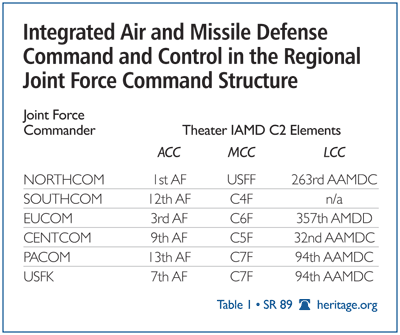
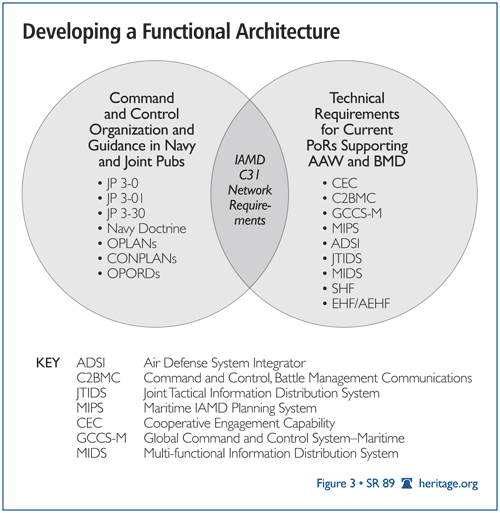
The Way Ahead
After identifying the problems associated with the need to develop reliable and effective connectivity to support the proper command and control of Aegis BMD, and after accounting for central planning factors already present in the management of the Aegis BMD system, it is possible to identify the specific steps necessary to improve the command and control system. These steps need to be taken under the Joint Capabilities Integration Development System (JCIDS) process at the Department of Defense. JCIDS is the process for integrating new technologies into U.S. military forces.
Specifically, these steps for improved Aegis BMD command and control must consider the relevant issues related to doctrine, organization, training, material, leadership, personnel, and facilities, as is generally appropriate for JCIDS studies. The steps should be designed to meet two overarching goals. The first is to preserve speed and unity of command in Aegis BMD command and control. The second is support the creation of an effective C3I network to support the Aegis BMD command and control system. (See Table 2.) The following are the broader steps that need to be taken:
- Develop a refined task force concept for integrated air and missile defense. This should build on the proposal that the Navy briefed to the Joint Chiefs of Staff in February 2010. Using the JCIDS process, this general step should determine required doctrine, organization, training, material, leadership, personnel, and facilities to support the concept. Finally, it should recommend the necessary investments for properly executing the concept.
- Publish a maritime concept of operations for integrated air and missile defense. This concept of operation will make it clear how missile defense fits into the myriad missions the Navy fulfills using its sea-based assets and assets in other domains, including space, some of which serve joint operations. This concept of operations, of necessity, will codify the system of command and control for integrated air and missile defense.
- In conjunction with other services and combatant commands, incorporate changes, as required, into Joint and Navy Doctrine (JP 3-01 Countering Air and Missile Threats). A refined Joint and Navy doctrine for the application of missile defense power is a necessary foundation for developing a truly effective command and control system for Aegis BMD.
- In consultation with the Joint Staff, the services, and the Missile Defense Agency, develop an objective functional architecture for integrated air and missile defense C3I networks. This architecture will provide both the organizational structure and the necessary hardware to maximize the effectiveness of Aegis BMD, including through the refinement of its command and control system.
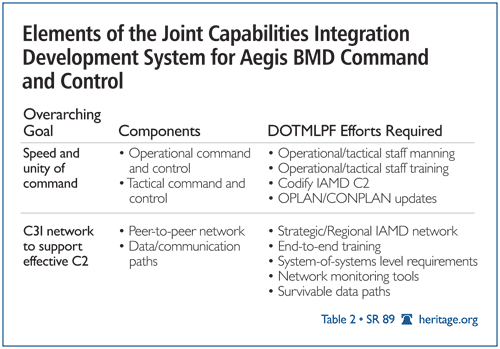
The broader steps outlined above, however, will necessarily lead to more specific steps to refine and improve Aegis BMD command and control. These more detailed steps fall into four areas.
Area #1: Pursuing Navy and Aegis BMD command and control development in conjunction with the requirements for joint integrated air and missile defense. The following are specific recommended steps for aligning Aegis BMD with both Navy and joint requirements:
- Assist the Joint Force Maritime Component Commander with integration of BMD force plans into his broader operational plan and, when necessary, by providing specific guidance to the force.
- Assist the Joint Force Maritime Component Commander with the formulation of guidance for BMD planned responses.
- Coordinate and control the use of maritime force BMD sensors.
- Control BMD communication networks, especially with respect to procedural integrity for communications security.
- Coordinate and control the employment of maritime force BMD weapons.
- Direct and control BMD actions of forces assigned these actions.
- Disseminate the criteria for weapon release and firing.
- Establish plans, policies, priorities, and overall requirements for the Joint Force Maritime Component Commander for BMD intelligence, surveillance, and reconnaissance (ISR) activities.
- Put in place the means for exercising command by negation of all BMD actions initiated by other units of the force.
- Identify the requirements for non-organic BMD support to the Joint Force Maritime Component Commander.
- Recommend BMD degrees of readiness to the Joint Force Maritime Component Commander because he cannot set the degree of readiness lower than that established by the Area Air Defense Commander.
- Support the combined task force designated by the Joint Force Maritime Component Commander to coordinate maritime force integrated air and missile defense operations, or, if not assigned, establish a direct liaison with the Area Air Defense Commandeer/Regional Air Defense Commander responsible for area air defense/regional defense operations from the maritime domain. (See Table 2.)
- Plan and coordinate BMD actions of forces assigned to the JFMCC.
Area #2: Meeting needs for managing BMD operations across the jurisdictional areas of the Geographic Combatant Commanders (GCCs). It is not uncommon for a ballistic missile launch point to be in one Geographic Combatant Commander’s area of responsibility (AOR) and the target in another GCC’s AOR. The targeted GCC is normally the supported commander for BMD operations. Joint Force Commanders (JFCs) must be able to coordinate across AORs to conduct effective BMD planning and execution. This includes coordinating network linkages that support ISR, command and control, and planning data exchanges and enabling collaboration and reachback with BMD agencies and commands. The BMD cell, other MOC staff members conducting BMD planning, and combined task force integrated air and missile defense (CTF IAMD) must therefore work closely, and their command normally must be granted direct line of authority (DIRLAUTH), with their counterparts in the adjacent theaters.
BMD across the boundary of a geographic combatant commander’s area of responsibility (cross-AOR BMD) typically is a theater-level operation, with the GCC of the targeted AOR normally the supported commander. Cross-AOR ballistic missile threats are the basis for global planning. Commander, U.S. Strategic Command is responsible for synchronizing planning for global missile defense and will do so in coordination with other combatant commands, the Services, and, as directed, appropriate U.S. government agencies.
Synchronizing and coordination responsibilities, however, do not include authority to execute or direct operations for cross-AOR BMD operations. Each GCC is responsible for BMD in his or her AOR. Support command relationships between GCCs for cross-AOR BMD that address specific AOR threats, international agreements, and partner-nation support requirements are defined by the Secretary of Defense. The JFC’s contingency plan (CONPLAN) discusses the GCC support command relationship for the AOR.
Area #3: Providing for operational and tactical control of multi-mission BMD-capable ships. By way of background, what is called a BMD cell is the maritime commander’s primary planning and execution coordination conduit with higher headquarters, other components, subordinate forces, and outside support agencies for meeting BMD mission requirements during execution.
If a subordinate combined task force (CTF) is designated as a maritime Regional Air Defense Commander, the BMD cell is the primary BMD coordination conduit between it and the maritime commander. Normally, the Joint Force Maritime Component Commander delegates operational or tactical control of multi-mission ships with a BMD capability and assigns BMD planning and command functions to the combined task force, which has the preponderance of multi-mission ships with BMD capability assigned to an operation. If activated and in place within the area of responsibility, these functions would be assigned to the combined task force’s integrated air and missile defense element. When designated, this element is the operational control authority to a numbered fleet commander or Joint Force Maritime Component Commander. This element is also intended to fulfill several distinct roles.
First, it is the primary maritime BMD planning element. The CTF participates in development of joint BMD plans and refines those plans for execution in the maritime environment. The element provides the Joint Force Maritime Component Commander with BMD asset allocation, mission prioritization, and stationing recommendations.
Second, during execution, this element may be given tactical control of multi-mission BMD-capable assets tasked with conducting long-range surveillance and tracking or BMD Surface Action Group (SAG) operations.
Finally, the element may act as a Regional Air Defense Commander.
Given these circumstances, the following are specific recommended steps for providing for operational and tactical control of multi-mission BMD-capable ships:
- Define requirements for protection of multi-mission ships with BMD capability.
- Exercise tactical control, including stationing and maneuvering of assigned multi-mission ships with BMD capability, in accordance with the Joint Force Maritime Component Commander’s policies and plans.
- Keep operational control and tactical control of multi-mission ships under a maritime commander, as a general matter, because it provides the most effective management of these valuable assets, maximizes warfighting capacity and capability across all component commanders, optimizes logistics support, and will ensure asset protection and safety of navigation.
The fact is that the multi-mission responsibilities of a BMD-capable ship must be carefully considered when delegating operational or tactical control. Unlike other tasks, missions, or specific warfare areas where the platform may conduct multiple tasks simultaneously, the stationing and systems requirements for conducting BMD may significantly limit the ship’s ability to conduct other tasks. This limitation on a high-demand, low-density asset may adversely affect the planning and execution of evolving maritime missions, where mission priorities can and do change.
Area #4: Providing for the specific needs of the Aegis Ashore system. Once deployed and activated, Aegis Ashore will constitute an enduring forward operating site, although the activated system could be removed within 120 days. Aegis Ashore consists of two distinct sections. The first section is the weapons system itself, which includes (among other elements) a command center with secure command, control, and communications; three eight-cell Vertical Launch System launchers; a SPY radar system; standard missiles; a launcher support building; and ordnance storage space. The second section is the Aegis Ashore Defense Facility, which primarily is the support infrastructure to serve the personnel manning the system.
The following are specific recommended steps for providing for command and control of the Aegis Ashore system:
- The combatant commander should delegate operational control of the Aegis Ashore system to the Navy Component Commander. This will ensure that naval officers, who are familiar with operating the Aegis system on ships, will maintain operational control of the ground-based system.
- When required, tactical control of the Aegis Ashore system should be delegated to the Area Air Defense Commander, who is responsible for support of the Area Air Defense Plan and the BMD mission.
- Administrative control of the Aegis Ashore system should rest with the Navy.
- At least initially, the Aegis Ashore system should operate under a U.S.-only command and control structure.
- At a later time, non-U.S. command and control structures could be integrated into the Aegis Ashore system. This will depend on how the Aegis Ashore system is linked to as-yet-undefined NATO systems for missile defense.
Acceleration of the Achievement of a Long-Range Missile Intercept Capability for Aegis: A Payoff from Making the SM-3 Missile “All It Can Be”
The Aegis BMD system is one of the most reliable and effective BMD systems in the country’s arsenal, but it is still not “All It Can Be.” Originally designed to intercept short- and medium-range missiles, the SM-3 missile now deployed has the potential to counter both long-range missiles and ICBMs.
Although the SM-3 Blk IA was not designed to shoot down ICBMs, the margins are sufficient to perform that mission as demonstrated in the satellite shoot-down in 2008. The satellite was traveling at 7.8 km per second, which is a little faster than a North Korean ICBM. The SM-3 is slower than the Ground Based Interceptor, but it is still fast enough to intercept ICBMs when shooting on a track with data delivered from forward-based radars. This concept falls under the Engage-On-Remote (EOR) capability, which is currently planned to be available in 2017.
The generic SM-3–defended area against an Iranian ICBM is shown in Figure 5. Although Ground Based Interceptors would likely provide adequate defense against this threat, the SM-3 missile would provide a backup capability in case there was a problem with the GBI. The Aegis ship must be in the terminal area to consummate the intercept. Figure 5 assumes that TPY-2 radars are placed ashore to provide the forward-based track. The shooter could be an Aegis ship or Aegis Ashore.
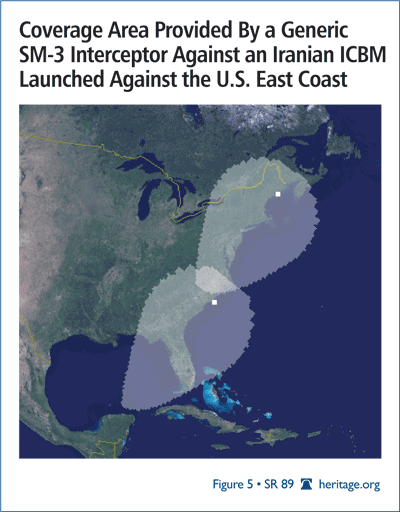
It is recommended that MDA fund EOR and SM-3 IB+ software changes (Frame Summing and Closing Velocity, which makes the IB more robust against ICBMs) so that they can be installed in Aegis BMD by 2015. It is also recommended that MDA include a requirement in its budget to test the SM-3’s ICBM capability as soon as it is technically feasible. SM-3 Blk 1A, 1B, and 2A should all be considered for use in the same test.
Conclusion
The military is moving in the right direction in terms of improving command and control for Aegis BMD. Accordingly, the recommendations made in this paper do not represent radical departures from the projected path. What they are designed to achieve is an acceleration in these improvements, both for increasing the reliability of the Aegis BMD system and for giving it the capability to counter more stressing missile threats.
One of the chief reasons for optimism regarding improvements in Aegis BMD command and control is that the issue is now starting to receive the attention it deserves. Specifically, the improvements are moving in the right direction because of significant cooperation between various elements of the Navy at the service level and between the Navy and the other services at the joint force level. This is taking place because the Joint Chiefs of Staff are coming to recognize that the Navy’s approach to improving Aegis command and control has applicability to the broader BMD system where the other services possess significant capabilities.
The Navy, for its part, recognizes that its Aegis BMD system needs access to off-board sensor data generated by systems that are outside its control through the improved command and control structure. Ultimately, this early access to off-board sensor data will permit the Aegis BMD system to launch interceptors at earlier junctures in the flight of the attacking missile. This early launch capability has the effect of improving overall reliability of the Aegis BMD system and, along with other steps, permitting it to intercept and destroy long-range, fast-flying missiles.
The Obama Administration’s Phased Adaptive Approach to missile defense can represent an appropriate vehicle for advancing the overall capabilities of the Aegis BMD system. Whether the Phased Adaptive Approach becomes such a vehicle will depend on providing proper funding and making sure that artificial obstacles are not placed in front of the Aegis program. The artificial obstacles could include (among others) arms control limitations, diplomatic constraints, excessive bureaucracy in the acquisition system, and inter-service rivalries.
Aegis BMD is emerging as a national capability for defending the U.S. and its allies against ballistic missile attack. It is certainly the case that this system can be made significantly more effective than it is today. Improving the system’s command and control structure is an essential component of the broader effort to upgrade its overall capabilities. The Obama Administration and Congress will not be serving the national security interests of the United States if they fail to make the Aegis BMD system all it can be.
Vice Admiral J. D. Williams, USN (Ret.), is former Commander of the Sixth Fleet and Deputy Chief of Naval Operations for Naval Warfare. While serving as the DCNO Naval Warfare in 1990–1992, he convinced the CNO and Secretary of the Navy to take on the mission of ballistic missile defense. He is considered the father of sea-based ballistic missile defense and currently serves as a defense consultant and as a member of the Ballistic Missile Defense Advisory Board for MIT Lincoln Laboratory.
Abbreviation Appendix
AA Aegis Ashore
AADC Area Air Defense Commander
AAMDC Army Air and Missile Defense Command
AO Area of Operations
ATO Air Tasking Order
C2 Command and Control
C3I Communication, Computer, Combat Systems, and Intelligence
CAL Critical Asset List
CCDR Combatant Commander
CRC RADC Counter-Air Operations Regional Air Defense Command
CTF IAMD Commander Task Force Integrated Air and Missile Defense
DAL Defended Asset List
IAMD Integrated Air and Missile Defense
ISR Intelligence, Surveillance, and Reconnaissance
JFACC Joint Force Air Component Commander
JFC Joint Force Commander
JFLCC Joint Force Land Component Commander
JFMCC Joint Force Maritime Component Commander
JIPTL Joint Integrated Prioritized Target List
JP Joint Publication
JTF Joint Task Force
LRC Logistics Readiness Center
LRS&T Long Range Surveillance and Tracking
MDA Missile Defense Agency
MIOC Maritime Intelligence Operations Center
MOC Maritime Operations Center
NWP Naval Warfare Publication
NTTP Navy Tactics, Techniques, and Procedures
OPCON Operational Control
OPORD Operation Order
RADC Regional Air Defense Command
ROE Rules of Engagement
SAG Surface Addition Group
SPINS Special Instructions
TACON Tactical Control

